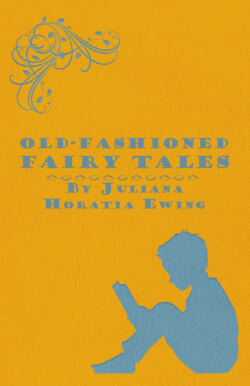Читать книгу Old-Fashioned Fairy Tales - Juliana Horatia Ewing - Страница 7
ОглавлениеPREFACE.
As the title of this story-book may possibly suggest that the tales are old fairy tales told afresh, it seems well to explain that this is not so.
Except for the use of common “properties” of Fairy Drama, and a scrupulous endeavour to conform to tradition in local colour and detail, the stories are all new.
They have appeared at intervals during some years past in “Aunt Judy’s Magazine for Young People,” and were written in conformity to certain theories respecting stories of this kind, with only two of which shall the kindly reader of prefaces be troubled.
First, that there are ideas and types, occurring in the myths of all countries, which are common properties, to use which does not lay the teller of fairy tales open to the charge of plagiarism. Such as the idea of the weak outwitting the strong; the failure of man to choose wisely when he may have his wish; or the desire of sprites to exchange their careless and unfettered existence for the pains and penalties of humanity, if they may thereby share in the hopes of the human soul.
Secondly, that in these household stories (the models for which were originally oral tradition) the thing most to be avoided is a discursive or descriptive style of writing. Brevity and epigram must ever be soul of their wit, and they should be written as tales that are told.
The degree in which, if at all, the following tales fulfil these conditions, nursery critics must decide.
There are older critics before whom fairy tales, as such, need excuse, even if they do not meet with positive disapprobation.
On this score I can only say that, for myself, I believe them to be—beyond all need of defence—most valuable literature for the young. I do not believe that wonder-tales confuse children’s ideas of truth. If there are young intellects so imperfect as to be incapable of distinguishing between fancy and falsehood, it is surely most desirable to develop in them the power to do so; but, as a rule, in childhood we appreciate the distinction with a vivacity which, as elders, our care-clogged memories fail to recall.
Moreover fairy tales have positive uses in education, which no cramming of facts, and no merely domestic fiction can serve.
Like Proverbs and Parables, they deal with first principles under the simplest forms. They convey knowledge of the world, shrewd lessons of virtue and vice, of common sense and sense of humour, of the seemly and the absurd, of pleasure and pain, success and failure, in narratives where the plot moves briskly and dramatically from a beginning to an end. They treat, not of the corner of a nursery or a playground, but of the world at large, and life in perspective; of forces visible and invisible; of Life, Death, and Immortality.
For causes obvious to the student of early myths, they foster sympathy with nature, and no class of child-literature has done so much to inculcate the love of animals.
They cultivate the Imagination, that great gift which time and experience lead one more and more to value—handmaid of Faith, of Hope, and, perhaps most of all, of Charity!
It is true that some of the old fairy tales do not teach the high and useful lessons that most of them do; and that they unquestionably deal now and again with phases of grown-up life, and with crimes and catastrophes, that seem unsuitable for nursery entertainment.
As to the latter question, it must be remembered that the brevity of the narrative—whether it be a love story or a robber story—deprives it of all harm; a point which writers of modern fairy tales do not always realize for their guidance.
The writer of the following tales has endeavoured to bear this principle in mind, and it is hoped that the morals—and it is of the essence of fairy tales to have a moral—of all of them are beyond reproach.
For the rest they are committed to the indulgence of the gentle reader.
Hans Anderssen, perhaps the greatest writer of modern fairy tales, was content to say:
“Fairy Tale Never Dies.”
J. H. E.
